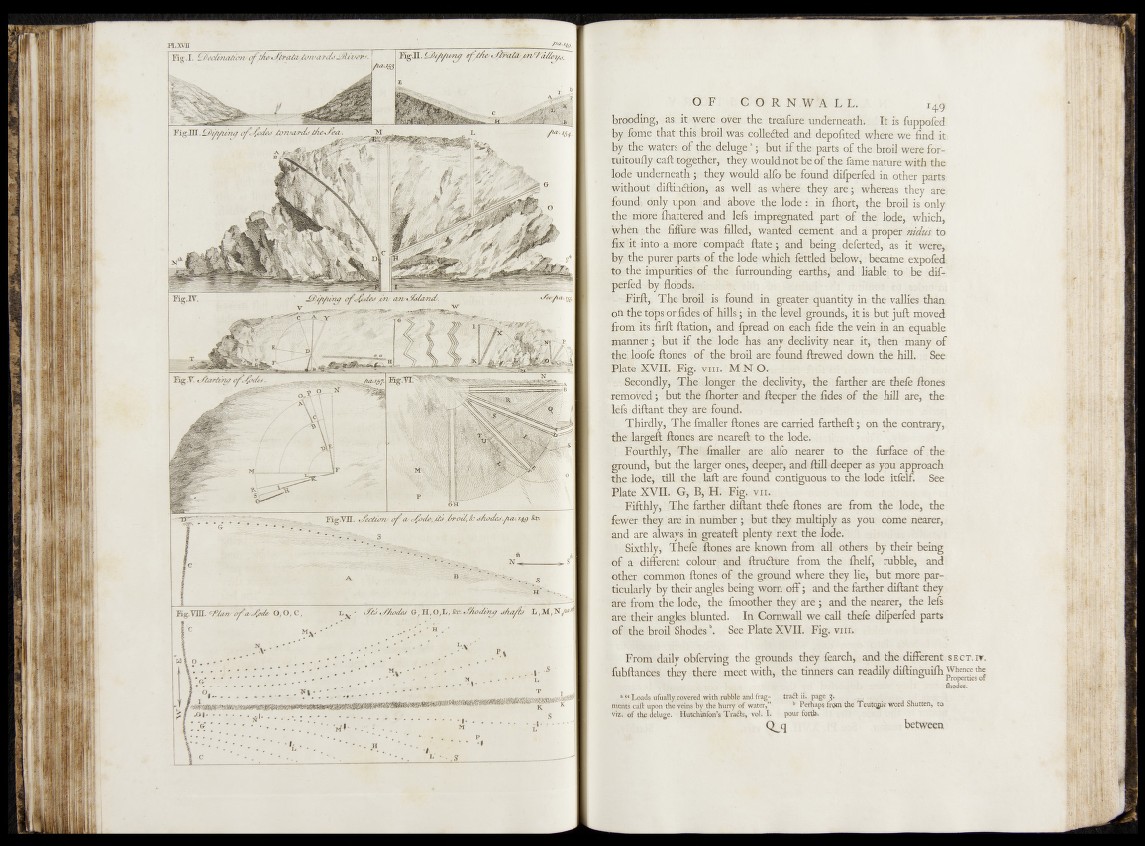
lïg . i . l,>v -
Fig JH. Q i.e f/ iin ç ofcffc/eo/£m M VrchjA6Jea/.
îSg.VJl. S ectio n / o f a/ d fode'/ffoffo*/*, o/wiùy.^io/. 74g fax
'M g .T S L '^â o n /o fa /tfo d e , 0 ,0 , C ,
I C M^. *
I j J ÿ x% ti,//uxÙj G , H ,0,1/, t e » f/io fó n jf jà a fh h
I* „v .£. j!ï; ^___j_S__
O F C O R N W 'A L L. H g
brooding, as it were over the treafure underneath. It is fuppofed
by feme that this broil was cohered and depofited: where we find it;
by the waters of the deluge ’ ; but i f the parts o£ the broil werefcr-
tuitoufly-caft together, they wouldnotbe of the fame nature with the
lpdé underneath ;othey would ; alfe; be found difperfed in other parts
without 'diftinâ:ià%' as. well'as where- they are; whereas they are
.foupd) only upon land above the lode : in- fhoft, the. broil is only
the : more fhattered and lefs impregnated part of the lode, which,
whtesthe fifîuMê -was filled, wantéd eement and a proper ® ^ to
fix 'it into a-more: eornpad ftate ; apd being, defected, as it were,
by. rthe purer parts of the lode which fettled belbw, became expofed.
to the impurities of the furrounding earths, and liable to ' be dif-
jperfed by flood^;-- '
feriFijfl,, The broil is found in greater: quantity in the vailles than
oft the tdps orfides of hills; in the level grounds, it is but juft moved
from its firft ftatión, and. fpread on each fide the vein in an equable
manner ; but if the lode has any declivity near it;'thenmany of
theildofe ftones of the broil are found ftrewed down the hill. See
Plàte XVII. Fig. w l M N O ,
-Secondly; The lon^r jh e declivity, die farther are thefe ftones
removed; but thé-lhorter and fteeper the fides o f the hill are, the
lefs diftànt they are found.
feTbirdly, The fmaller ftones are carried faxtheft ; on the contrary,
the largqft ftones arc neareft to the lode.
' Fourthly; The ftnaller are alfb nearer to the lùrfàce of the
ground, but the larger ones, deeper, and ftill deeper as you approach
the lode, till the, laft are found contiguous to the lode itfelf. See
Plate XVII. G; B; H. Fig. vu.
• Fifthly, The farther diftant thefe ftones are from the lode, the
fewer they are in number ; but they multiply as you come nearer,
and are always in greateft plenty next the lode.
' Sixthly, Thefe ftones are known from all others by their being
of a different colour-and ftruffcure from the ftielf, rubble, and
other common ftones of the ground where they lie, but more particularly
by their angles being worn off ; and the farther diftant they
are from the lode, the fmoother they are ; and die nearer, the lefs
are their angles blunted. In Cornwall we call thefe difperfed parts
of the broil Shodes \ See Plate XVII. Fig. vm»
From daily obferving the grounds they fearch, and the different sect.it.
fubftances they there meet with, the tinners can readily diftinguifh
fliodes.
4 Loads ufually covered with rubble and frag- tra£t ii, page 3»
riants caft upon the veins by „the hurry of water,” b Perhaps from the Teutonic word Shutten, to .
viz, of the deluge, Hutchinfon’s Tra&s, vol, I* pour forth.
Q_q between